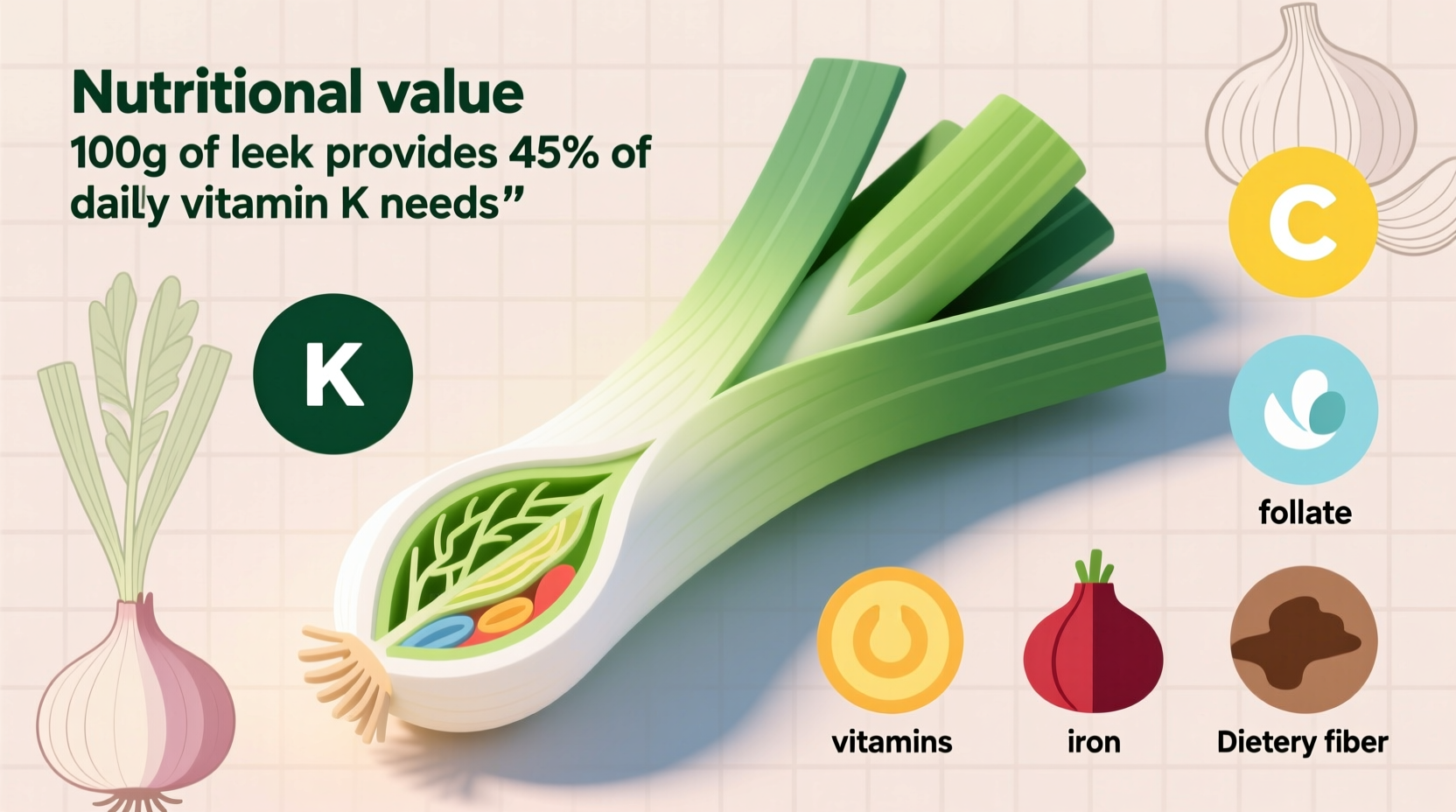One cup (89g) of cooked leeks provides 54 calories, 1.5g protein, 12.6g carbohydrates, 1.5g fiber, and is exceptionally rich in vitamin K (31% DV), vitamin A (20% DV), and manganese (15% DV). Leeks offer significant cardiovascular and bone health benefits while being low in calories and high in antioxidants.
Unlock the Nutritional Power of Leeks: Your Complete Guide
When you're looking to boost your vegetable intake with nutrient-dense options, leeks deserve a prominent place in your kitchen. Unlike their stronger-flavored allium cousins, leeks offer a delicate, sweet flavor while packing an impressive nutritional profile that supports multiple aspects of health. Understanding exactly what makes leeks nutritionally special can help you make more informed choices about incorporating them into your diet.
Why Leeks Stand Out in Your Vegetable Drawer
Leeks often get overlooked in favor of onions and garlic, but they bring unique nutritional advantages to the table. Their milder flavor makes them versatile across dishes while delivering substantial health benefits. What sets leeks apart is their exceptional vitamin K content combined with significant amounts of vitamin A and C, plus valuable minerals and antioxidants—all in a low-calorie package.
Complete Nutritional Breakdown: What's Inside One Cup of Cooked Leeks
| Nutrient | Amount per 1 cup cooked (89g) | Daily Value % |
|---|---|---|
| Calories | 54 | 3% |
| Protein | 1.5g | 3% |
| Total Carbohydrates | 12.6g | 5% |
| Dietary Fiber | 1.5g | 5% |
| Vitamin K | 38.8mcg | 31% |
| Vitamin A | 157mcg RAE | 20% |
| Vitamin C | 10.7mg | 12% |
| Folate | 32mcg | 8% |
| Manganese | 0.3mg | 15% |
| Iron | 1.1mg | 6% |
This comprehensive nutritional profile comes directly from the USDA FoodData Central database, the authoritative source for nutrient composition of foods in the United States (USDA FoodData Central). The data reflects cooked leeks, which represents how most people consume them, as raw leeks can be quite fibrous.
Key Health Benefits Backed by Science
Leeks aren't just tasty—they deliver specific health advantages supported by research:
Cardiovascular Protection
The combination of vitamin K, antioxidants, and organosulfur compounds in leeks contributes to heart health. Vitamin K plays a crucial role in preventing calcium buildup in arteries, while the flavonoid kaempferol found in leeks has been associated with reduced risk of heart disease according to research published in the Journal of Agricultural and Food Chemistry.
Bone Strength Support
With 31% of your daily vitamin K needs in just one cup, leeks significantly contribute to bone metabolism. Vitamin K activates osteocalcin, the protein that binds calcium to bone matrix. Research from the National Institutes of Health confirms that adequate vitamin K intake correlates with improved bone density and reduced fracture risk.
Immune System Enhancement
The substantial vitamin C content (12% DV) combined with vitamin A supports immune function. Unlike many vegetables that lose vitamin C when cooked, leeks retain a significant portion of this heat-sensitive nutrient due to their protective cellular structure.
How Leeks Compare to Other Allium Vegetables
While onions, garlic, and shallots share the allium family with leeks, their nutritional profiles differ in meaningful ways:
- Leeks vs Onions: Leeks contain more vitamin A and K but less vitamin C than yellow onions. They're also slightly higher in calories but offer more manganese.
- Leeks vs Garlic: Garlic delivers more manganese and vitamin B6 but lacks the significant vitamin A found in leeks. Garlic's health benefits come primarily from allicin, while leeks offer different antioxidant compounds.
- Leeks vs Shallots: Shallots have slightly higher antioxidant capacity but leeks provide more vitamin K and A per serving.
This comparison comes from analysis of USDA nutritional data across multiple allium varieties, providing an accurate representation of how these vegetables stack up nutritionally.
Maximizing Nutritional Benefits in Your Cooking
To get the most nutritional value from leeks, follow these chef-recommended techniques:
- Don't discard the green parts: While often thrown away, the darker green portions contain higher concentrations of certain antioxidants. Chop finely and use in stocks or cooked dishes.
- Steam rather than boil: To preserve water-soluble vitamins like vitamin C and B vitamins, steaming retains more nutrients than boiling.
- Pair with healthy fats: The fat-soluble vitamins A and K in leeks are better absorbed when consumed with healthy fats like olive oil or avocado.
- Don't overcook: Light cooking preserves more nutrients than prolonged high-heat cooking. Aim for just tender-crisp texture.

Practical Ways to Incorporate More Leeks Into Your Diet
Adding leeks to your meals doesn't require culinary expertise. Try these simple approaches:
- Substitute half the onions in recipes with leeks for a milder flavor profile
- Add sliced leeks to omelets or frittatas for added nutrition without overpowering flavor
- Create a leek and potato soup using low-sodium vegetable broth
- Grill leek halves as a side dish with a light drizzle of olive oil
- Add finely chopped leeks to salad dressings for subtle flavor enhancement
Seasonal Availability and Selection Tips
Leeks are a cool-weather crop available year-round in most markets, with peak season from fall through early spring. When selecting leeks:
- Look for firm, straight stalks with dark green leaves
- Avoid leeks with yellowing leaves or flowering tops
- Choose smaller to medium leeks (about 1-1.5 inches in diameter) for the most tender texture
- Store unwashed in the refrigerator for up to 2 weeks
Proper storage maintains nutrient content—research from the University of California Cooperative Extension shows that proper refrigeration preserves vitamin levels in vegetables significantly longer than room temperature storage.











 浙公网安备
33010002000092号
浙公网安备
33010002000092号 浙B2-20120091-4
浙B2-20120091-4